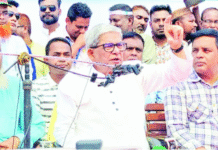Dead rivers tell many tales

Dead men tell no tales, but rivers do. Bangladesh’s rivers, a large number of which have already been killed with the remaining survivors crawling towards death, tell so many tales – tales of crooked politics, spiralling transportation costs, of waning productivity and of a dying ecosystem.
Each of Bangladesh’s rivers has a story, too, entwined in love and tragedy. The rivers, over a thousand rivers, began with a fairy tale, forming this unique and fertile deltaic land, but in course time, most of them have died a miserable death. Today, the skeletons of the rivers leave so many inglorious stories behind.
The sheer volume of the atrocities which the rivers in this country have had to face, is staggering. A few recent offences against the rivers, especially against the two major rivers — Buriganga and Karnaphuli, lifelines of the capital city, Dhaka, and business capital, Chattogram respectively — are recapitulated here to portray the gravity of the situation.
The pollution and encroachment of the rivers have already hit rock-bottom.
Statistics say in the last 567 months since the independence, Bangladesh has lost more than three-fourths of the cheapest and easiest navigable waterways. The country had approximately 24,000 km of inland waterways after the independence. However, because of constant pollution, encroachment and scarcity of water, Bangladesh now has 3,865 km of navigable waterways during the dry season and 5,968 km during the rainy season. This is declining every year.
These are just numerical facts.
The real-life experiences are worse. After visiting 160 rivers in Bangladesh’s northern region Rangpur, Begum Rokeya University teacher Tuhin Wadud, also a national river activist, wrote in Prothom Alo in February this year that of 160 rivers, ‘some are choked by encroachment, some are ploughed for farming crops while some are simply falling prey to the government’s development initiatives. The rivers are either grabbed by political parties or local powerful people’ (Prothom Alo 18 February 2019). He discovered more than 200 rivers in Rangpur division, though Bangladesh Water Development Board (BWDB) found only 82 names in the division out of 405 rivers of the country.
Another Prothom Alo report on the same day read that Rajshahi’s nine rivers – Narad, Shandya, Swaramangala, Doya, Barahi, Hoja, Nabaganaga, Chinarkup and Musakhan – have been killed in the name of flood protection.
Eight days after the report, another one cropped up in Prothom Alo, reading, ‘Dhanshiri is dead.’ A photo of the 130-km river shows the dried-up bed of the river. The river Dhanshiri has been immortal for Jibananda’s poem ‘Abar Ashibo Phire’, where he wrote ‘Abar Ashibo Phire Dhanshiriti Tire, Ei Banglay.’
These are just some random instances. Atrocities against rivers are now an everyday phenomenon.
At the end of the January this year, the government began a drive to clear up the dying river Buriganga, following a court order. The number of encroachers and structures built on the banks of the river reveal the intensity of the danger. From households to business groups to politicians, everyone was on the list of polluters and encroachers.
Between 29 January and 7 February this year, the Bangladesh Inland Water Transport Authorities (BIWTA) demolished nearly 1,200 illegal structures on the banks of Buriganga. Most of the illegal encroachers were either politicians or powerful businessmen. The authorities found 175 encroachers along 12 kilometres of the Buriganga stretching between Kamrangichar and Pangaon in the old part of Dhaka. The list of the encroachers includes MPs from both ruling and opposition parties and local politicians while the structures comprise illegal dockyards, residential buildings, warehouses and industries.
Coincidently, following a separate court order, the administration in Chattogram launched an eviction drive on the banks of Karnaphuli. The river is one of the major streams for Bangladesh as well as for the business capital both economically and ecologically. In 2015, the Chattogram district administration made a list of 2,122 illegal structures. The structures include illegal jetties, dockyards, shops, hotels, garages and even clubs. From youth groups to ‘petty rich’ to business conglomerates to politicians, every stakeholder of the society was on the grabbers’ list.
The pollution data of the Buriganga is even more frightening. Three years ago, the Environment Department estimates that 60,000 cumecs (cubic metre per second) of toxic water, mostly from dying and washing factories, was emitted into the Buriganga water. According to Keraniganj Washing Owners Association, each of the factories in the area use 25-30 thousands of litres of water per day. As per the calculation, 1.8 million litres of toxic water was discharged into the Buriganga from the area alone. In addition, households on the banks discharge 900 cumecs untreated wastewater into the Buriganga every day.
These are not stories of Buriganga and Karnaphuli alone. All rivers, especially the rivers along the cities, are now in the same state.
The results are very much expected. The dying rivers have ranked Bangladesh’s capital the worst livable place in the world and put the country in front of some harsh realities. Its transportation costs have been scaled up while the productivity of its soil has significantly decreased. Its ecosystem has already reached the boundaries of no return.
In a study in May 2009 on ‘Ecological Health Risk of Buriganga river’, a couple of Khulna University researchers came up with some scary findings. For suitability of aquatic animals, the water in a river should have a minimum balanced temperature, hardness, Biological Oxygen Demand (BOD), Phosphate (PO4-3), and Dissolved Oxygen (DO) and a few other factors. But, the Dhaka river has failed to meet any of the criteria to become a safe habitat for aquatic animals. This aquatic environment of the river has rendered it no longer livable for aquatics.
Other rivers — Balu, Sitalakhhya and Turag — in and around Dhaka are no exception. The rivers have already ‘ceased to be habitats for fish, other aquatic life and plants, whereas they were once replete with a wide variety of native fish such as bowal, chital apart from dolphin, crab and other aquatic animals’ (The New Age, 23 March 2017).

The productivity of the affected areas has significantly decreased. The World Bank in a study titled “People’s Republic of Bangladesh Revival of Inland Water Transport: Options and Strategies” found ‘in polluted areas, some 45% of households report persistent losses in the production of rice, and more than 20% are experiencing production losses in vegetable crops. It is estimated that agricultural and fisheries production in the Dhaka Statistical Metropolitan Area (DSMA) may be reduced by about one third as a result of poor water quality.’
The pollution has significantly upped costs by 22% for industries and 40% for the health sector. The World Bank shows a comparative carrying cost between waterways, the railway and road transportation. ‘IWT tariffs for cargo are below Tk 1 per ton-km whereas the tarrifs are around Tk 4.5 for road while rail tariffs up to Tk 4.’ The study reads ‘the tariff to transport a 20-foot container, for instance, is around Tk 600 per ton by IWT, compared to Tk 1,200 for rail and Tk 6,000 for road.’
Following the persistent threats, in September 2009, the government declared Buriganga, Sitalakhaya, Turag and Balu rivers as Ecologically Critical Areas (ECAs).
The BIWTA has launched a hotline to save rivers from pollution and encroachment in February this year.
Bangladesh’s apex court made history declaring the rivers of the country living beings on January 30 this year. Through the court’s order, the rivers have been declared a ‘juristic or legal person.’ “It means the rivers have been given fundamental rights like human being” (BBC, 31 January 2019). This is a third court verdict in this kind in the history of humankind followed by New Zealand and India.
But, none of the efforts could save the rivers. While the eviction continues in Buriganga, pollution continues too as does the grabbing in the other parts of the river and on the banks of other rivers. The rivers and their impact are so extensive that a single course of action, a particular authority or a certain community is not enough to put up an effective fight against the carnage. The problem is recurrent, so the action should be relentless. The action should come from every corner of society and from each and every one of us.










